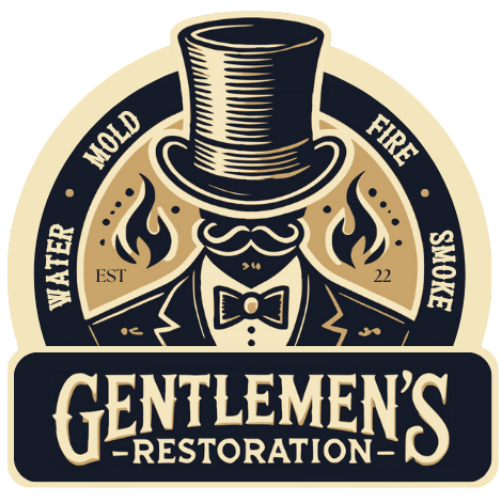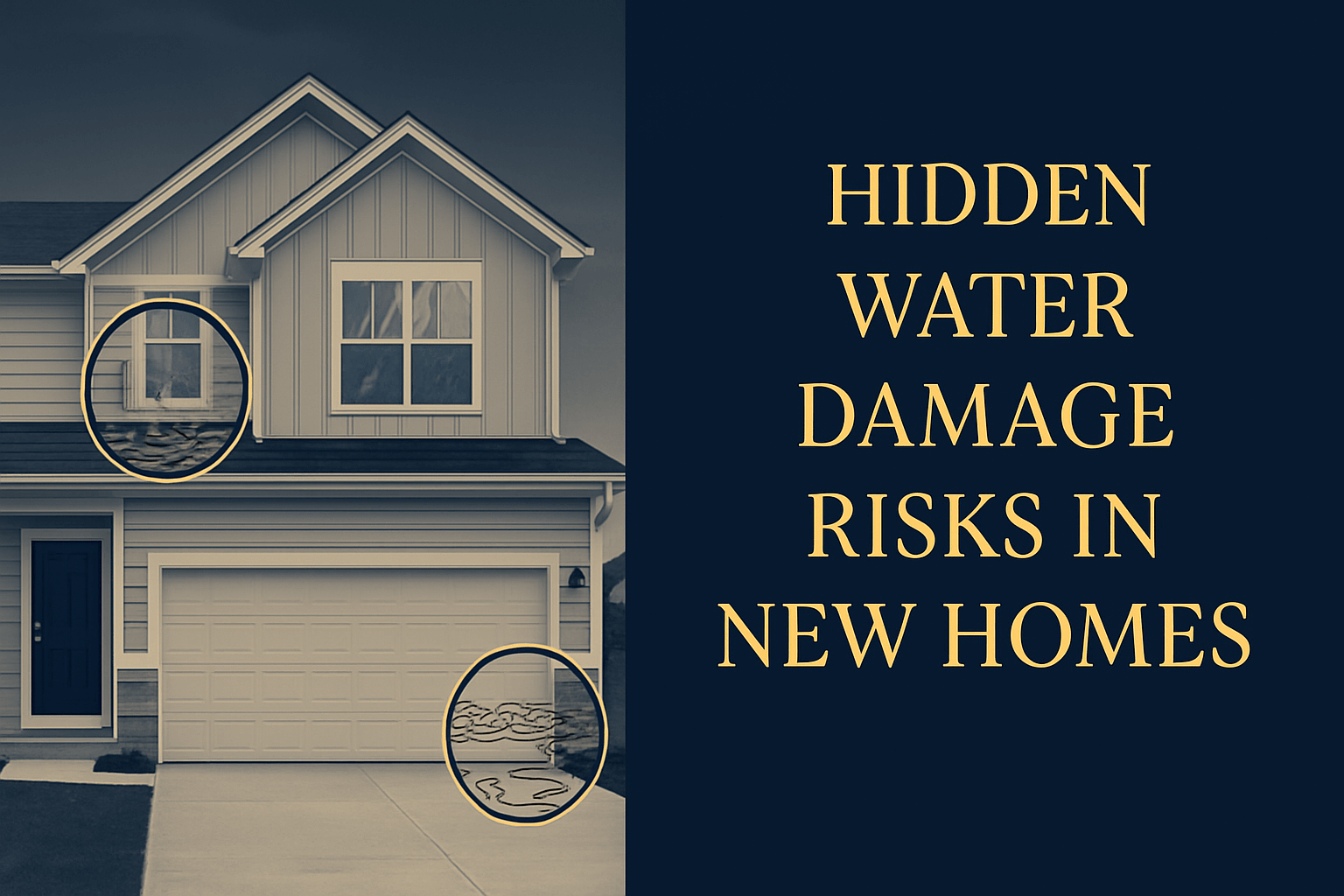What to Look For Before You Buy
A Gentleman’s Guide to Protecting Your Investment
The allure of a newly constructed home is undeniable—pristine finishes, modern amenities, and the promise of minimal maintenance concerns. However, at Gentlemen’s Restoration, our experience has taught us that even new construction can harbor hidden water damage risks that may not become apparent until months or years after purchase.
A true gentleman approaches any significant investment with diligence and foresight. This comprehensive guide will equip you with the knowledge to identify potential water damage vulnerabilities in new homes, ensuring your investment remains sound for years to come.
Foundation and Grading Issues: The Bedrock of Water Management
Improper Grading and Drainage
- Insufficient Slope: New construction sites should have a minimum 6-inch drop in elevation within the first 10 feet extending from the foundation. Inadequate grading can direct water toward your foundation rather than away from it.
- Settling Soil: Newly backfilled soil around foundations naturally settles over time, potentially creating depressions that collect water against the foundation walls.
- Drainage System Deficiencies: Verify that downspouts extend at least 5-6 feet from the foundation and that the property includes proper drainage solutions for low-lying areas.
Foundation Vulnerabilities
- Hairline Cracks: While some minor settling cracks are normal in new construction, horizontal cracks or those wider than 1/8 inch may indicate structural issues that could lead to water intrusion.
- Waterproofing Shortcuts: Budget-conscious builders may apply minimal waterproofing to foundation walls. Look for evidence of proper waterproofing membranes and drainage systems around the foundation.
- Improper Window Well Installation: Basement window wells should include proper drainage and be installed with appropriate clearance above soil level to prevent water entry.
Plumbing System Oversights: Hidden Behind the Walls
Installation Deficiencies
- Rushed Connections: In today’s fast-paced construction environment, plumbing connections may be hastily completed. Look for signs of amateur workmanship such as misaligned pipes or excessive use of sealants.
- Incompatible Materials: When different types of plumbing materials connect (such as copper to galvanized steel), without proper dielectric unions, corrosion can occur rapidly, leading to leaks.
- Improperly Secured Pipes: Pipes that aren’t properly secured can create water hammer effects when water flow stops suddenly, potentially damaging connections over time.
Pressure and Quality Issues
- Excessive Water Pressure: New homes may have water pressure set too high (above 80 psi), which can stress plumbing systems and lead to premature failure of fixtures and connections.
- Inadequate Pipe Insulation: Even in new construction, pipes in exterior walls or unheated spaces may lack proper insulation, creating freeze risks in colder climates.
- Water Quality Considerations: Some new developments may have water with high mineral content that can accelerate wear on plumbing systems if appropriate water treatment isn’t installed.
Roof and Attic Vulnerabilities: Above-the-Head Hazards
Roofing Shortcuts
- Improper Flashing Installation: Flashing around chimneys, vents, skylights, and where roof planes meet walls are common failure points, even in new construction.
- Inadequate Underlayment: Some builders may use minimal underlayment beneath shingles, providing insufficient secondary protection against water intrusion.
- Ventilation Deficiencies: Proper attic ventilation is crucial to prevent condensation issues. New homes should have appropriate intake and exhaust venting to maintain proper airflow.
Attic Concerns
- Bathroom Fan Venting: Improperly vented bathroom fans that terminate in the attic rather than outside the home can cause significant moisture accumulation and eventual water damage.
- Insulation Placement: Insulation that blocks soffit vents can lead to poor ventilation and moisture buildup in attic spaces.
- HVAC System Condensation: Air handler units or ductwork in attics can produce condensation if improperly insulated, leading to water damage that may go unnoticed for extended periods.
Window and Door Installation: Entry Points for Moisture
Window Vulnerabilities
- Improper Flashing and Sealing: Windows must be properly flashed and sealed during installation to prevent water intrusion around the frames.
- Inadequate Sloping: Window sills should have a slight outward slope to direct water away from the home. Flat or inward-sloping sills can channel water into the wall cavity.
- Low-Quality Materials: Some builders may install lower-grade windows that are more prone to seal failure and condensation issues.
Door Considerations
- Threshold Sealing: Exterior door thresholds should be properly sealed to the subfloor to prevent water infiltration during heavy rain events.
- Weatherstripping Quality: Even new doors may have inadequate weatherstripping that allows water to penetrate during wind-driven rain.
- Sliding Door Tracks: Sliding patio door tracks often collect water and can leak into the wall structure if drainage channels are improperly designed or blocked.
HVAC System Considerations: Condensation Concerns
Condensate Drainage Issues
- Improper Drain Slope: Condensate drain lines from air conditioning systems must be properly sloped to ensure complete drainage. Even minor installation errors can lead to backups and overflows.
- Missing Overflow Protection: Modern HVAC systems should include secondary drain pans and overflow shutoff switches, but these safety features are sometimes overlooked in new construction.
- Drain Line Termination: Verify that condensate drain lines properly terminate outside the home or into appropriate drain systems, not into crawlspaces or near the foundation.
Ductwork Vulnerabilities
- Condensation on Ductwork: Poorly insulated ductwork in unconditioned spaces can develop condensation, leading to water damage in surrounding materials.
- Leaky Connections: Ductwork connections should be properly sealed to prevent conditioned air from escaping into wall cavities or attic spaces, which can create condensation issues.
- Return Air Placement: Improperly placed return air intakes can create negative pressure issues that draw humid outside air into wall cavities, potentially causing hidden moisture problems.
Bathroom and Kitchen Construction: High-Risk Areas
Shower and Tub Enclosures
- Waterproofing Membrane Deficiencies: Modern shower installations should include proper waterproofing membranes beneath tile, but this critical step is sometimes rushed or improperly executed.
- Grout and Caulk Application: Even in new construction, grout and caulk may be improperly applied or of insufficient quality to provide lasting water resistance.
- Shower Pan Installation: Prefabricated shower pans must be properly installed with appropriate slope and sealing to prevent leakage at the edges and drain connections.
Kitchen Considerations
- Dishwasher and Refrigerator Connections: Water supply lines to these appliances should include easily accessible shutoff valves and be properly secured to prevent movement and potential disconnection.
- Sink Plumbing: Under-sink plumbing should be properly aligned and secured, with special attention to garbage disposal connections, which are common leak points.
- Backsplash Integration: Kitchen backsplashes should be properly sealed where they meet countertops to prevent water infiltration behind cabinets.
Smart Prevention: The Modern Gentleman’s Approach
Water Detection Technology
- Whole-House Water Monitors: Consider installing devices that attach to your main water line and can detect unusual flow patterns, automatically shutting off the water if a leak is detected.
- Point-of-Use Water Sensors: Place wireless water sensors near washing machines, water heaters, under sinks, and other high-risk areas. These affordable devices can alert you via smartphone if moisture is detected.
- Smart Water Valves: These can be controlled remotely via smartphone apps, allowing you to shut off your water supply from anywhere if an issue arises.
Professional Inspection Considerations
- Beyond the Standard Inspection: Consider hiring a specialist who focuses specifically on water damage and moisture issues to supplement your standard home inspection.
- Infrared Thermal Imaging: This technology can detect temperature differences that may indicate moisture behind walls or ceilings, revealing issues that visual inspections might miss.
- Moisture Meter Assessment: Professional-grade moisture meters can detect elevated moisture levels in materials that appear dry to the touch, potentially revealing hidden issues.
Conclusion: Diligence Preserves Investment
At Gentlemen’s Restoration, we believe that informed diligence is the hallmark of a wise homebuyer. While new construction offers many advantages, understanding these potential water damage vulnerabilities allows you to address concerns before they become costly problems.
Remember that even the most minor water intrusion, left unaddressed, can lead to significant damage over time. By identifying these risks early—ideally before completing your purchase—you protect not only your financial investment but also the sanctuary that your home represents.
Should you discover water damage issues in your new home, contact Gentlemen’s Restoration immediately at 469.912.2300. Our 24/7 emergency response team combines old-world craftsmanship with modern expertise to address water damage promptly and properly, preserving the value and integrity of your home.
Download our printable Hidden Water Damage Risks in New Homes Checklist to help you evaluate properties before purchase.
For emergency water damage assistance, contact Gentlemen’s Restoration at 469.912.2300 – available 24/7.

